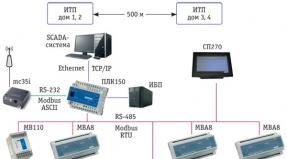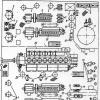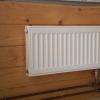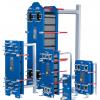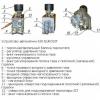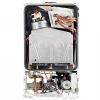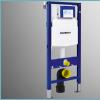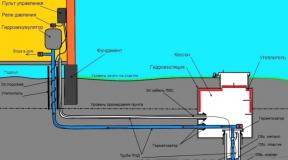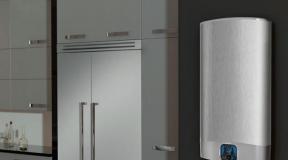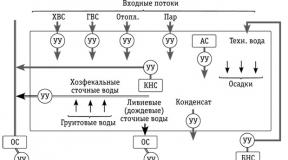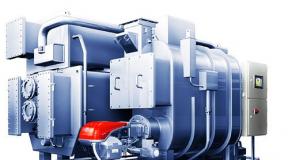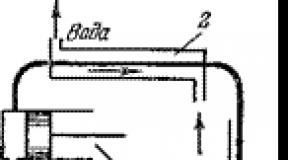Thermostatic head installation. The design of the thermal head for the heating radiator. Thermostat for a heating radiator working principle
The article describes in detail how a thermal head works on a heating radiator, the principle of operation and installation of a thermal head on a heating radiator. Before starting work, carefully read the instructions provided. The article contains complete information to get the job done from start to finish. Choose only trusted manufacturers, do not skimp on devices, the quality is worth it!
Thermostatic head working principle
- The main sensor is a bellows, in which liquid or gas is under a certain pressure. The adjustment spring is responsible for balancing the device, which compresses the bellows when we set the temperature we need by turning the rotary knob.
Thermostatic head working principle
Note!
The better the device is calibrated, the more accurately it will respond to temperature changes.
At the same time, the price of such high-precision thermal heads will be appropriate.
- As the temperature rises, the volume of the bellows increases (mainly due to gas expansion or partial evaporation of the working fluid).
- Increasing the volume of the bellows causes the stem retaining spring to release and the valve gradually closes the pipe.
- This continues until equilibrium is established inside the device, or until the radiator valve under the thermal head is completely closed, i.e. the stem will not move to the lowest position.
Expanded models work in a similar way. The only difference is that either special programmable devices (climate control systems) or remote sensors (liquid, gas or electronic) react to temperature changes. Only then does the information go to the thermal valve mechanism and actuates the stem.
Read also:
Installing a thermal head on a heating radiator
Before starting work, it is important to know how to properly install the thermal head on the radiator, the further functionality of the device will depend on this.
What you need:
- Thermal head
- Tapping dies
- Fumlenta
- Two adjustable wrenches
- Locknuts
Preparatory work
Making threads on pipes

Head assembly
Types of thermal heads
All manufactured thermal heads can be conditionally divided into two types:
Mechanical, which is manually adjusted;
Electronic, controlling the process of regulation in automatic mode.
Mechanical models are small-sized heads with a rotary handle. The temperature range that can be controlled starts from + 7 ° and goes up to + 28 °. The device provides several modes of operation. Each division of the temperature scale is equivalent to 2-5 degrees.
In electronic models, the entire adjustment process is automated. The adjustment accuracy corresponds to 1-2 degrees. Flexible control system allows you to set the most suitable heating mode.
Thermal head setting
After the user familiarized himself with the design of the device, learned how the thermal head works on the heating radiator, setting the optimal microclimate in each room is not difficult. By rotating the knob relative to the scale with marks, you can adjust the temperature within the range of +5 - +28 degrees.
In the first case, the system is guaranteed not to freeze in the absence of the owners inside the building of periodic operation. The maximum value is considered comfortable for users. The substance with which the bellows chamber is filled reacts to an increase / decrease in temperature within 1 degree. Therefore, the valve on / off cycles will occur regularly.
Thus, any home craftsman can choose and mount the thermal head together with the valve. To do this, it is enough to take into account the above factors, to avoid major installation errors.
The thermal head in 90% of cases is used to lower the air temperature. However, in a country cottage, by installing heads with valves on all registers, the temperature can be raised. In rooms farther from the boiler, the heat loss in the heating circuit is maximum. Therefore, when the supply is cut off in the near registers, hot water heats up the ones far from the boiler room better.
prof-kirpich.ru
types, principle of operation + installation rules
A device such as a thermal head for a heating radiator is designed to adjust the heating temperature. With its help, you can more efficiently use the coolant and save money.
The guaranteed effect from use is the right choice. To do this, you must have as much information as possible about these devices.
From this article, you will learn about the existing types of thermal heads, the device, the principle of operation and the rules for their installation on radiators.
Features of the structure of the thermal head
The most popular thermal head consists of a body, bellows, locking element, pusher, stem (closure cone), return spring, sealing and fasteners.
The amount of coolant passed into the radiator is controlled by the valve device. Most products are equipped with this element.
The plastic body is made by hot stamping. It can be either transparent or colored - from white to black. The bellows are made of brass or galvanized steel. In most models, the body of the thermal head for installation on the radiator and the heating element are compatible.
The bellows filler gas condensate has the highest reaction rate to temperature fluctuations.

Two stainless steel springs help to open and close the stem. One of them returns the stem to its original position after the valve is closed, and the second after opening it
There is a locking element on the body at the very top. It is needed to fix the settings. If the settings have not been changed for a long period or the moving elements of the device are inactive, they can stick to it.
There is such a thing as "gestosis" of the head. The smaller it is, the faster the device responds to temperature changes.
Types of thermal heads and how they work
Thermal heads belong to shut-off and control valves. There are three types of thermostatic heads:
- manual;
- mechanical;
- electronic.
The functions are all the same, but the implementation methods are different. Depending on the last parameter, they have different capabilities.
What are handheld thermal heads?
By design, thermostatic heads duplicate a standard tap. By turning the regulator, you can adjust the volume of the coolant transported through the pipeline.

By setting the thermostat just 1 ° lower, you can save 6% of the amount you have to pay for electricity in a year
They are mounted instead of ball valves on opposite sides of the radiator. They are reliable and inexpensive, but you will have to operate them manually, and turning the valve every time, relying solely on your feelings, is not very comfortable. Basically, such thermal heads are installed on cast iron batteries.
If you switch the valve stem several times a day, the valve flywheel will weaken. As a result, the thermal head will quickly fail.
Features of mechanical thermal heads
Thermal heads of mechanical type have a more complex design and they maintain the set temperature in automatic mode.
The device is based on a bellows in the form of a small flexible cylinder. Inside it is a temperature agent in liquid or gaseous form. As a rule, it has a high coefficient of thermal expansion.
As soon as the specified temperature indicator exceeds the norm, under the influence of the internal environment, which has greatly increased in volume, the rod begins to move.
As a result, the cross-section of the through passage of the thermal head is narrowed. At the same time, the throughput of the battery decreases, and, consequently, the temperature of the coolant to the set parameters.
As the liquid or gas in the bellows cools, the cylinder loses its volume. The rod rises, increasing the dose of the coolant passing through the radiator. The latter gradually warms up, the equilibrium of the system is restored and everything starts all over again.
A positive result will be only if there are thermostats in all rooms and on each radiator.
Devices with liquid filled bellows are more popular. Although the reaction of gases is faster, the technology of their production is rather complicated, and the difference in measurement accuracy is only 0.5%.

A mechanical regulator is more convenient to use than a manual one. He is fully responsible for the indoor microclimate. There are many models of such a thermal valve, which differ from each other in the way of signaling.
The thermostatic head is mounted so that it is oriented towards the room. This will improve the accuracy of the temperature measurement.
If there are no conditions for such an installation, a thermostat with a remote sensor is mounted. It is connected to the thermal head by a capillary tube with a length of 2 to 3 m.
The expediency of using an external sensor is due to the following circumstances:
- The heater is placed in a niche.
- The radiator is 160 mm deep.
- The thermal head is hidden behind the blinds.
- Large width of the window sill above the radiator, while the distance between it and the top of the battery is less than 100 mm.
- The balancing device is located vertically.
All manipulations with the radiator will be performed with an orientation to the temperature in the room.
What is the difference between electronic thermal heads?
Since, in addition to electronics, such a thermostat contains batteries (2 pcs.), It is larger in size than the previous ones. The stem moves here under the influence of the microprocessor.
These devices have a wide range of additional functions. So, they can set the temperature by the clock - it will be cooler in the room at night, and the temperature will rise by morning.
It is possible to program temperature readings for individual days of the week. Without reducing the level of comfort, you can significantly save on heating your home.
Although the batteries have enough charge to last for several years, they still need to be monitored. But the main disadvantage is not this, but the high price of electronic thermal heads.

The photo shows a thermal head with a remote sensor version. It limits the temperature to the set value. Adjustment is possible from 60 to 90 °
If a decorative screen is installed on the radiator, the thermal head will be useless. In this case, a regulator with a sensor that records the external temperature is required.
Thermal head installation rules
The connection point when installing the thermal head on the radiator does not depend on its type. In any case, this is a pipe that directly supplies the coolant to the battery.
For the device to work correctly, air must circulate around it continuously.
- The housing must be protected from direct UV rays. Otherwise, the device will not work accurately.
- The thermal head must be open. It should not be hidden by any protective boxes, furniture.
- The device must not be located above the heating pipes. In this case, there will be a mismatch between the room temperature and the area around the head.
- If the device is practically isolated, you need to arrange a bypass line or install a bypass valve in the area of \u200b\u200b\\ u200b \\ u200bthe supply pipe and return.
- The piping to be connected must not exert pressure on the valve body.
During installation, the thermohead regulator must be set to maximum. This will ensure correct operation of the device. Immediately before installation, the movement of water or other coolant in the circuit must be shut off, then drained.

It is forbidden to install the thermal head vertically. It should be parallel to the floor. This position ensures that it is not affected by warm air.
Instrument installation sequence
Installation must begin with cutting pipes, which is performed, stepping back a little from the radiator. The next step is to dismantle the existing shut-off valves. Further, the shanks are separated from the valves and screwed into the radiator plugs.
The piping is mounted in place, having previously assembled it, the pipes are connected. It remains to adjust the temperature by turning the thermostat knob until the notches match the existing marks on the body corresponding to a certain temperature.

It is important that the arrow on the body points in the direction of the hot coolant flow in the system. Otherwise, the work is done in vain, nothing will work. The thermal head can be installed both at the inlet and at the outlet.
But not all batteries have an upper supply, it can be lower. If there is no sample of suitable height, exit in the setting of the thermal head to a lower temperature.
Since the floor is cooler and the appliance is set to the temperature that should be at the top of the battery, it will be hot in the room. To avoid this, you can install a thermal head with a remote sensor. There is also such an option as self-tuning the regulator.
Features of the setup
For normal operation of the device, a preliminary configuration is required. Before that, they turn on the heating and isolate the room by closing the door.
A thermometer is installed at a certain point and the setting is started:
- Turn the thermal head to the left until it stops so that the coolant flow is completely open.
- Wait until the temperature rises by 5-6 ° compared to the initial one.
- Turn the head all the way to the right.
- When the temperature drops to the desired value, the valve is gradually unscrewed. The rotation is stopped when noise appears in the radiator and the case warms.
The last position of the thermal head corresponds to a comfortable temperature. She will be constantly supported.

Built-in programs are incorporated into the design of electronic thermal heads. They make it possible to adjust the temperature with great accuracy - up to 1 degree
The sequence described is suitable for most instruments. If it is different, then it is not difficult to fulfill it, since everything is detailed in the passport.
What are the criteria for choosing a thermal head?
Thermal control devices are produced by many manufacturers. To make the right choice, you need to be guided by the following criteria:
- Thermal valve to which the head will be attached... Since the connection can be clip-on or threaded, you need to pay attention to this point. If the manufacturer is the same, there will be no problem.
- Type of threaded connection on the head itself... It can be in the form of a nut with shutters or just round. In the first case, during installation, an additional tool is needed to crimp the connection. In the second, everything is much simpler.
- The presence of a "skirt"... The head looks better with it, because it closes the work area.
- Manufacturing material... The cheapest are thermal heads in a plastic case. The expensive models have a metal case.
- Plastic quality... Some manufacturers use the cheapest type of plastic in order to reduce the cost of their products. The strength of the structure suffers from this, and over time the plastic turns yellow and loses its aesthetic appearance.
- Work item type... The choice will have to be made between liquid, gas, electronic and paraffin.
- Smooth rotation... The handle should rotate smoothly. This is a sign of good quality. All sorts of crackles, squeaks and seizures indicate a not quite high-quality product.
- Graduation and scale length... For most models, it is in the range +5 - +30 ° C. If the scale is located around the entire perimeter of the head, it can quickly wear off.
- The presence of an anti-vandal casing... It protects against unauthorized access to settings.
- Design... Since thermal heads are mostly visible, their appearance and color scheme are important.
It is not necessary to purchase a ready-made kit consisting of a thermal valve and a thermal head. These devices can be purchased separately.

The gas-filled bellows are not too sensitive to external heat sources. This is a definite plus, but its cost is much higher than that of a liquid bellows.
A thermal head equipped with automation wins a lot, but it is not always effective. It makes no sense to mount it on cast iron radiators. This material is very heat-intensive, and since the mass of the battery is large, it has great inertness. Only the manual type of head can work correctly here.
Most popular brands
The right decision when buying a thermal head is to focus on reputable manufacturers. An unfamiliar trademark with an unknown history is a big risk of wasting money.
You can safely purchase products from manufacturers such as Dunfoss, Oventrop, Caleffi, Salus and other well-known companies.
Place # 1 - Danfoss
Danfoss has been producing thermal heads for over 60 years. This is a Danish manufacturer; under its license, products are also produced in Russia. The most frequently asked is the RTS Everis thermal head.
It is a liquid filled bellows product. Mates with branded thermal valves by direct fixing. Others require an adapter.

The range of equipment for the automation of heating systems from the Danfoss concern is rich and meets advanced technologies. You can control the work and adjust the thermal heads remotely using a smartphone for this
Rank # 2 - Oventrop brand
Oventrop thermal heads from the Uni line are in great demand among consumers. They are equipped with a liquid bellows. They are connected to the thermal valve using a union nut. The temperature can be set within the range of +7 - +28 ° C.
There is a possibility of complete closure. The heads are designed for the maximum temperature in the system +100 - +120 ° C - these are the characteristics indicated by the manufacturer in the accompanying documentation.

Oventrop Uni heads are compatible with other plumbing products from this company. They can be connected without an adapter to other devices with a built-in valve and corresponding thread
Install them on thermostatic valves with a suitable connection. On the heads of many series there is a special mark for people with low vision, an anti-vandal casing.
Place # 3 - Thermo
Consumers of the Swiss company Thermo, in particular, the Royal Thermo RTE 50.30 model, highly appreciated it. It has a wide control range - from +6 to +28 ° C, a low hysteresis value - 0.55 degrees. There is also a zero position.
For correct operation, the coolant must have a temperature not higher than 100 ° C. Coupling with the valve - union nut.

Thermo thermal heads are distinguished by their reliability and build quality. Among the offers there are models with a remote sensor
Place # 4 - Producer Caleffi
The Italian manufacturer Caleffi supplies a wide range of radiator thermal heads. The Caleffi 210000 model is programmable. It is equipped with a digital liquid crystal temperature display. In addition to the temperature value, it shows the time, date, set daily program.

When buying equipment for heating systems, be sure to ask the seller for supporting documents, manufacturer's warranty and product instructions
When programming for a week, you can set 3 temperature levels: "Comfort", "Economy", "Anti-freeze". This head is installed in tandem with Keleffi valves.
Place # 5 - Salus
The German firm Salus also enjoys a well-deserved reputation. For example, the Salus PH 60 model is an electronic head with non-volatile memory, the ability to set the temperature regime for a week. Temperature range - +5 - +40 ° C.
Power supply is carried out from 2 AA cells. The display has the function of backlighting and displaying temperature parameters, as well as the charge level of the cells.

New development - mini-thermal head wireless, powered by batteries. You can control the device through a computer or smartphone, after downloading the Smart Home application
Conclusions and useful video on the topic
Test of existing types of thermal heads:
Thermostatic valve and head in action:
A heating circuit with a thermal head is more convenient to use. This device increases the service life of the equipment included in the heating system, increases the level of its fire safety.
Based on the usefulness of these relatively simple devices and their 20-year lifespan, the cost is low. To buy a really high quality product, find out if there is a certificate for the selected device.
sovet-ingenera.com
Thermostat for a heating radiator. Installation
The uniform temperature distribution in all directions ensures thermal comfort in the room. In order to achieve it, it is necessary to take a responsible approach to the design of the heating system: to the choice of devices, the location of radiators, taking into account the thermal insulation characteristics of the room.
[hideshow]
Since any heating system is constantly under high load, it is necessary to take all possible measures to prevent breakdowns or accidents. In front of the heating radiators must be installed shut-off valves, this will allow in an unforeseen situation ( accident, failure) disconnect the radiator without negatively affecting the entire system.
In some cases, the shut-off valve can also be used for temperature control, but since it has only two standard positions ( on / off), its presence in an intermediate position may cause its breakdown or depressurization of the system.
That is why it is recommended to use thermostat for heating radiator, the price of which is quite low.
The installed thermostat provides room temperature control by changing the volume of the coolant directly in the heating radiator itself.
Classification of thermostats
These devices can be classified both by the method of receiving the signal and by their design features.
There are three ways the thermostats receive signals, these are from the radiator, from the air temperature in the room and outside.

It should be noted that the types of thermostats described above can be installed at the same time. According to the design features, thermostats are divided into:
- Direct acting thermostats. Installation is carried out directly into the pipeline of the heating system, and regulation is carried out by closing the pipe with a valve;
- Electrically controlled thermostats. The thermostat and sensor are installed in the room where it is necessary to control the temperature, and the thermostat is near the collector;
- Electric thermostats. Temperature control is carried out by turning on and off the circulation pump or boiler burner, the installation is carried out directly to the heating equipment.
On the lack of one thermostat, video:
The principle of operation of the thermal head for radiators
Currently, the market for plumbing products is rich in various models of thermostats, the design of the simplest consists of a valve and a thermostatic head.
In order to understand the operation of this system, it is necessary to study in detail the principle of operation of the thermal head for radiators.
The design of the valves is familiar to everyone, but not everyone knows the components of the thermal head. This element of the heating system consists of parts such as a regulator, an actuator and a fluid element ( bellows) with corrugated walls. 
It is the working medium of the bellows that affects the temperature change.
At high temperatures, the bellows stretches and blocks the passage of the coolant, otherwise ( at low temperature), the liquid element is compressed, leading to an increase in the amount of coolant entering the heating radiator.
It should be noted that thermostats react exclusively to the room temperature and the temperature of the heating radiator itself does not affect their operation.
The thermal head, installed in a horizontal position, will prevent the possible effect of warm air emanating from the radiator on it; another way out of the situation is to install an external temperature sensor.
Installing a thermostat on a heating radiator
The installation of this device is carried out by installing it on the radiator pipe. To ensure proper functioning, the installation of the thermostat on the heating radiator should be performed in the following sequence:
- Overlapping the pressure section of the heat conduit and draining the coolant. In order to facilitate the installation, it is recommended to install the thermostat before the start of the heating season, in this case it is not necessary to drain the water from the heating system;
- Preparing the seat.A cut is made of the horizontal supply section, and the application of a thread on both sides of the rams. In the event that a valve is installed on the pipe, it must be dismantled;
- Mounting the thermostat housing.A lock nut is screwed onto the overhang located on the side of the riser, after which it is wrapped with a sealing tape. The thermostat itself is screwed onto this nut, like a pipe. To connect this structure with the second squeegee, a lock nut is also screwed onto it. Fixing the thermostat housing is carried out simultaneously on both sides using adjustable wrenches;
- Installation of the control element. The thermal head for the heating radiator is screwed into the adapter located on the regulator body. This allows you to replace the control unit in the event that it fails or you select a more advanced model.
Setting the thermostat
It is important to know not only how to install the thermal head on the radiator, but also how to adjust it, because any regulating element must be adjusted before commissioning.
The temperature controller is configured as follows:
- To ensure a stable microclimate in the room, all windows and doors must be closed. Drafts or heat flows from adjacent rooms can adversely affect the thermostat setting;
- A stand is placed in the center of the room, the height of which is equal to half the height of the room and a thermometer is installed on it;
- The valve of the thermostat is fully opened, which provides heating to the maximum temperature;
- After the temperature in the room rises by 5-7 degrees, the valve is turned all the way in the opposite direction;
- Next, you need to follow the temperature drop on the thermometer, at the moment when its value reaches the temperature you want, you need to smoothly turn the valve to the left until there is a noise of water in the regulator. This stage is final.
After adjustment, you can draw a vertical strip along the valve position or make a small notch, this will help you calibrate other desired temperature conditions in the future.
It is worth noting that some models of thermostats have their own scale and to adjust the modes, you just need to compare the indicator indicated on it with the temperature in the room.
Advantages of modern thermostats
The models of temperature controllers that are currently available are not only convenient to use, but also have an aesthetic appearance suitable for the interior of almost any room.
It should be noted that the installation of these devices is not difficult not only in new heating systems, but also in existing ones. In addition, according to experts, they have a sufficiently long operational period, during which preventive and maintenance is practically not required. After installing thermostats, there is no need to regulate the temperature regime by opening windows or doors.

The temperature range for normal operation of this device is 5-27 ° C, you can choose the required temperature mode yourself and it will be maintained in the room accurate to 1 ° C. In addition, the thermostat installed on the radiator allows you to prevent excessive heating of the air in the room by direct sunlight, electrical appliances or a large number of people.
Thermoregulators are able not only to create thermal comfort in the room, but also to provide uniform distribution of the coolant throughout the heating system. In the event that the device is installed on the boiler, absolutely all radiators will have the same temperature, even those that are at the maximum distance from it.
Currently, electric batteries with a thermostat are produced, this device is installed on them immediately at the factory.
It is worth noting that when installing the thermostat, it is best to start with those rooms in which there are sharp temperature fluctuations, for example, a kitchen, rooms on the sunny side, or a living room, in which a large number of people can gather at the same time. 
Quite often, thermostats are used in autonomous heating systems, since when installing them fuel costs are reduced by 25%. This, in turn, reduces the amount of harmful waste resulting from its combustion, and reduces the cost of heating.
The advantages of using thermostats in the heating system are quite significant, their particular efficiency can be noted in private houses and cottages, because in this case the installation of these devices pays off due to fuel savings in literally a year.
The installation of thermostats in private houses should be started from the upper floors, since there is usually a significant difference between the temperature on the lower floors and the temperature in the upper rooms.
High economic efficiency can be provided by panel radiatorshaving a significant reaction rate to the opening and closing of the thermostat valves.
When choosing a thermostat, you should pay attention to the presence of a certificate of quality and conformity, high-quality devices always have such documents. The operational life of such products reaches 20 years.
Room thermostat, video:
In order for the installation of the thermostat not to turn into problems for you, we present some useful tips:
- When purchasing a thermostat for a heating radiator, make sure that the warranty period for the device is at least 3 years;
- Do not believe the inscriptions on the packages and check the country of origin solely by the barcode numbers, since most often thermostats are assembled in China or Korea;
- Buy thermostats only in specialized stores or departments;
- Make sure that in the room where the thermostat is installed, no additional heating devices are present, as this may interfere with its action, and you will not achieve the desired temperature regime;
- It is not recommended to install thermostats in niches, as well as to close them with any objects or curtains.
The temperature controller for the heating radiator can be installed independently, because for this you only need a wrench and the installation instructions that are included with the device. Only you decide what should be the temperature in the room!
relend.ru
How to properly install the thermal head on the battery
- What will be needed for installation?
- About the principle of operation of the thermal head
- Frequent installation errors
- Step by step instructions for correct installation
- Useful articles

1. What will be needed for installation?
2. On the principle of operation of the thermal head
To understand how to properly install the thermostatic head on the battery, it is important to understand its design. When the operating principle is clear, it is easy to avoid installation problems.
The valve consists of two parts - a control valve and a thermostatic element. Turning the knob, adjust the temperature regime. At the same time they are guided by a scale with numbers or dots - they combine the desired one with the risk on the case. Between the valve seat and its cone there is a distance that determines the amount of water coming from the heating system to the radiator. The movement of the cone is controlled by a thermostatic element. It reacts to changes in air temperature in the room due to gas condensate filling - a heat-sensitive liquid. Thus, there is an automatic adjustment of the coolant flow depending on changes in the air temperature in the room. It is kept at the same level, comfortable for the user, for example, 20 - 22 ° C.

Maintaining a constant room temperature is the main advantage of the thermal head. To lower it, you do not need to open doors and windows (this is especially not beneficial to the owners of their own boiler room - after all, the resources spent on heating literally fly out the window). Using control equipment saves 10 - 20% of thermal energy. And finally, one more argument in favor of installing the thermal head on the battery is the rather simple installation and independence of its operation from the mains.

As you can see, the principle of operation of a conventional mechanical thermostatic valve is quite simple. However, the accuracy of its operation largely depends on the correct installation. Therefore, before talking about the installation process, we will tell you how you should not install the thermal head on the battery.
3. Frequent installation mistakes
The most common mistake is the vertical position of the head above the valve at the top of the radiator. Many users find this method to be aesthetic and convenient. But this negatively affects the operation of the element. The fact is that the hot air rising from the pipe heats the head - the temperature in this place becomes much higher than in the room. The device perceives this as exceeding the comfort level, decides that the room is hot, and turns off the radiator. As a result, the room is no longer heated.
Incorrect installation locations also include areas where the air temperature is very different from the average temperature in the room. For example, the radiator is hidden in a niche, and a thermal head is installed there. It reacts to heat in an enclosed space and turns off the radiator. The same thing happens if the valve is located deep under the windowsill, is located in direct sunlight, and is closed by blackout curtains, furniture, etc. Another incorrect option is to install a thermostatic valve in a place that gets under the flow of cold air, for example, at the edge of a window opening, where there are often drafts. In this case, the device will "think" that it is cold in the room - the heating temperature will rise, and unbearable heat will begin in the room.
As you can see, the wrong place to install the thermal head practically negates the point of using it. According to experts, it is better not to put the valve on the radiator at all than to carry out incorrect installation.
Remember: the installation location of the thermostatic head must be such that the average room temperature is reflected. Then the device will correctly respond to temperature and maintain a comfortable mode.
4. Step by step instructions for correct installation
Preparatory work
Typically, the installation of a thermal head on the battery is carried out along with the installation of new radiators. To do this, you need to close the riser and drain the coolant remaining in the pipes into a bucket. It is best not to carry out work during the heating season.
Choosing a place to install the thermal head
Given the errors in the installation of the thermostatic head, which we talked about above, we can draw conclusions about where it is definitely not worth installing the thermal head. What are the best options? It is important that heat fluxes from the radiator do not fall on it and are not affected by factors that can cause false perception of temperature.
The photos below show common options for properly installing the thermostatic head on batteries. If it is mounted at the top of the radiator, it should only be placed horizontally. In the lower part, it can be mounted horizontally and vertically, since there are no strong heat flows of heated air - it rises upward.
Making threads on pipes
To fix the head on the radiator, it is necessary to cut the threads at the connection points. To do this, on the squeegees coming from the riser and the radiator, the threads are cut using a die.
Head assembly
A locknut is screwed to the squeegee coming from the riser. It is wrapped with fumlent, and a thermostat is screwed onto it, but the fasteners are not tightened. Next, do the same with the squeegee coming from the radiator. The installed thermal head must be secured - simultaneously tighten both nuts with two adjustable wrenches.

Device setup
Close all windows and doors to keep warmth out of the room. Place a support in the center of the room, such as a stepladder. Place a thermometer on it. It should be at a height equal to half the height of the room. Turn the valve on the thermal head to maximum. The room will be warmed up to the maximum temperature. Watch the reading of the thermometer. The thermometer column will rise: as soon as the temperature rises by 5 - 7 ° C, turn the temperature control knob in the opposite direction. The flow of the coolant will decrease, which means that the temperature in the room will begin to decrease. Watch for a drop in thermometer readings. When you see the desired value, for example, 22 ° C, turn the knob of the thermal head to increase until you hear the sound of water in its body. You can remember the position of the handle and make a mark on the case. Leave the thermostat in this position. Some devices have a temperature scale, and during the setup process, you just have to check with it.

Advice: at the end of the heating season, remove the thermal heads from the radiators. Prolonged inactivity can lead to sticking of moving parts of devices. Removing them will extend the life of important parts.
Now you know how to properly install the thermal head on the battery and how to avoid mistakes. You can easily cope with this task. It remains only to buy everything you need for installation - you can do it in our online store. We offer only branded products: radiators and thermostatic heads for them. Do not forget to purchase related elements: Mayevsky's tap, shut-off valves and other useful little things, without which no heating system can do. If you need advice, call the manager of our company. He will help you choose everything you need.
5. Useful articles
How to bleed air from the battery? Learning to use the Mayevsky crane
Which radiator to choose and which is better?
How to cut threads by hand? Threading tool overview
How to make a warm floor: a detailed guide
Water and electric towel warmers, what's the difference?
How to choose electric boilers
How to equip your own boiler room?
www.vseinstrumenti.ru
Thermal heads for heating radiators: device and installation features
 Deciding to create an autonomous heating system in the house, the owner expects it to be reliable enough, demonstrate high efficiency in work and require a minimum of maintenance costs. Despite the fact that this problem has many possible solutions, still most often the owners choose a method such as installing heating radiators with temperature controllers. Their feature is that these devices are able to maintain the thermal regime in the room at the required level.
Deciding to create an autonomous heating system in the house, the owner expects it to be reliable enough, demonstrate high efficiency in work and require a minimum of maintenance costs. Despite the fact that this problem has many possible solutions, still most often the owners choose a method such as installing heating radiators with temperature controllers. Their feature is that these devices are able to maintain the thermal regime in the room at the required level.
Naturally, these devices have alternatives, which are shut-off and control valves and ball valves, as well as cone valves. However, due to the inherent disadvantages of these products, their use is not effective.
Features of temperature control by ball valve and valve:
When starting to install radiators using a valve or ball valve, it should be borne in mind that:

An effective solution to eliminate these disadvantages is to add a device such as a thermal head to the system. With this device much easier to adjust heat dissipation. Accordingly, the owner has the opportunity to reduce the cost of heating.
Thermal head design
Despite the fact that many thermal heads from different manufacturers are available on the market today, in general they have a common device that can differ only in individual elements.
The basis of the design of these products is formed by two units, which are independent devices:
- Valve;
- Thermostatic element.
The main purpose of the valve is to adjust the water supply process. Straight and angle valves are available for sale. This element can also be manufactured in standard solutions RTD-G and RTD-N.
How devices work

If the radiators are equipped with such a thermostat, then there is no danger that it will get the same temperature as the water circulating in the water supply. This is due to the design of these elements, thanks to which the regulator is activated only in cases where there are fluctuations in the temperature of the air in the room. This effect is achieved due to the bellows vapor, which, in any situation, accumulates in the coolest zone of the device. Thus, it is always located at the maximum distance from the valve, to which heat is transferred from the water.
It is very important to provide protection from the warm air that the radiator creates. Thermal heads, which should be placed strictly horizontally, can solve this problem. Although this is most often done, you can do everything differently - install a remote sensor.
Thermal head selection
At the stage of choosing a thermostat, you should pay attention to such characteristics as filling, which can be liquid or gas-filled. If liquid is used, then the capabilities of the device allow the actuator to be informed about how much the temperature has changed. But the liquid device has a serious disadvantage: it demonstrates increased inertia, which is what differs from gas-filled devices. The use of the latter does not allow achieving a high-precision reaction on the part of the actuator, however, all of them will do this much faster.
 Even before deciding on the brand and model of equipment, you need to decide how exactly their measuring unit will be installed. Let's say, about thermal heads for Danfoss radiators, it can be noted that they provide several options: with remote or integrated sensor, and also there are models that allow you to control the thermostatic element at a distance using a special remote control.
Even before deciding on the brand and model of equipment, you need to decide how exactly their measuring unit will be installed. Let's say, about thermal heads for Danfoss radiators, it can be noted that they provide several options: with remote or integrated sensor, and also there are models that allow you to control the thermostatic element at a distance using a special remote control.
Often on radiators you can find thermal heads with a built-in sensor. Already by the name of this category of devices, one can understand exactly how the active element is placed. When installing heating radiators that are equipped with thermoelements of this type, it is important to remember that:
- If vertical placement is more suitable for the element, then the option of purchasing other devices should be considered. The fact is that when using the built-in temperature sensor, small inaccuracies in operation will be observed, the cause of which is the increased heating created by the outgoing convection flows.
- For this type of sensor, only horizontal placement is permissible.
It is worth thinking about installing thermostatic elements with remote control only when the layout of the heating devices does not allow the owner to get to them. Among the considered category of devices, consumers quite often install Danfoss R. A. 5068 or RA 5074 models.
Installation and commissioning technology
Mounting
 The installation of heating radiators is accompanied by the placement of a valve on the inlet heating radiator, for which a standard wrench is used. Moreover, it should be placed so that the coolant circulates in the same direction as the arrow on the housing. For the correct installation of thermostatic elements, you must follow the instructions, which in most cases manufacturers apply to equipment packaging. It is worth noting that you can choose the optimal thermal regime before installing the sensor. You just need to perform the necessary manipulations with the protective cap, which is located on the valve body.
The installation of heating radiators is accompanied by the placement of a valve on the inlet heating radiator, for which a standard wrench is used. Moreover, it should be placed so that the coolant circulates in the same direction as the arrow on the housing. For the correct installation of thermostatic elements, you must follow the instructions, which in most cases manufacturers apply to equipment packaging. It is worth noting that you can choose the optimal thermal regime before installing the sensor. You just need to perform the necessary manipulations with the protective cap, which is located on the valve body.
Thermal head setting
Thermostatic elements allow you to select any temperature within the range of 6–26 ° C. This makes it possible to adjust the thermal regime taking into account the characteristics of each particular room in the house. Afterwards no need to monitor the temperature, as it will be maintained automatically. If necessary, it will be lowered or increased.
Changing the thermostat parameters is quite simple. This is done by moving the handle to a position where the indices on the body align with the mark or arrow. By these indices, it is easy to understand in what temperature regime the thermal heads for radiators function.
Also, the user has the ability to adjust the temperature range Xp (P-zone). If it exceeds the critical values, this will lead to the transfer of the valve cone from one extreme position to another. If radiators are equipped with temperature regulators designed for European standards, then for the latter this parameter has a value of 2 ° C.
Particular attention should be paid to the P-zone: it will decrease as the flow rate of the valve decreases. If required, the owner has the ability to set the lower and upper limits for the operating range. For more information about this parameter, look at the instructions that came with the device.
Thus, for the effective use of a device such as a thermal head, one should not only choose it correctly, but also configure it. Then, in addition to creating an optimal thermal regime the owner will have the opportunity to save on heating. After all, most often consumers do not realize that each of them has the opportunity to pay less for heating their home. Moreover, in order to fully experience all the benefits of such a device as a thermal head, it is not required to make serious changes to the design of the radiator and spend a lot of money for installation.
The expended efforts are fully compensated by the positive effect, which is not limited only to the creation of an optimal microclimate.
kotel.guru
Thermal head for a heating radiator: installation and adjustment
A thermal head for a heating radiator without connecting to a valve is an almost useless element of the heating system. Inside the element there is a sensor that is triggered by changes in the room temperature. In a bellows-type chamber, there is a substance in a liquid or gaseous state that changes volume during the operation of the heating system.
The chamber is connected to the stem, the latter completely overlaps the thermal head with the valve or will open it to the required regulation level. This is where it differs from a control valve. The latter can change the flow of the heat carrier within a narrow range inside the heating register.
Part characteristic
The thermal head for a heating radiator must be installed only in one-pipe systems with a bypass. When the valve is triggered, the flow of the coolant is completely shut off, there is no circulation in the heating circuits in the device. The solution to the problem consists in a bypass tube, along the cross section of which the coolant will move.
Therefore, in the section of the coolant supply pipeline, a valve is cut into the radiator, then the thermal head for the radiator is screwed on. The direction of movement of the control element must be perpendicular to the fluid flow.
Views and configuration
Specialists highlighted the following variations of the thermostat of the heating system:
- One-pipe systems are quite rare, they are successfully produced by the modern company Danfoss. Popular are RA-G, RTD-G.
- Most of the thermostat heads of heating systems belong to two-pipe systems - for many companies the volume of such production reaches 97%.

One-pipe heating systems
The masters can distinguish the visual heads for a system of 2 pipes by the size of the adjustment cap and color:
- Single-pipe circuits have large devices in gray or white.
- Small diameter caps are placed on the heads of 2-pipe systems with high pressure and low flow.
Arrows are indicated on the body, indicating the direction of the heat flux; installation in the other direction is not allowed. That is why it is necessary to take into account how water enters the radiators of various rooms: from above or below.
The operation of a thermostat for a heating radiator has the simplest principle: a person sets the desired temperature in the room, for this there is a scale on the device with divisions - 21 degrees will correspond to the value 3.
Scale adjustment
A change in temperature by 1 degree upwards leads to heating of the substance inside the chamber, it grows in volume and presses on the valve stem. Hot water stops flowing into the radiator structure, while due to the bypass, the circulation of the coolant in the heating circuits is maintained.
The register will lead to a decrease in temperature, the volume of the substance will decrease, the pressure on the stem decreases, as a result of which the valve opens. In this case, the temperature control will be effective only for radiators with low inertia.
Heating devices made of aluminum, steel or two metals will heat up or cool down quickly, so automatic adjustments with thermal heads are suitable for them. Radiators made of cast iron change their temperature for a long time, accumulate heat, the efficiency of adjustments using thermal heads decreases.
Subtleties of the element design
Experts identify two principles by which a thermal head should be selected for the heating system of a house or apartment.

Mechanical fluid thermal head
According to the substance inside, the thermal heads are divided into liquid structures and gas-filled ones.
The first type is distinguished by more accurate temperature indicators, and the second is characterized by high reliability and speed. It is by the type of control that mechanical and electronic thermostats are distinguished.
The mechanical regulator does not require power from the mains, this design has important advantages:
- the cost is lower compared to the electronic version;
- the operation is quite simple;
- no dependence on energy.
But at the same time there is a drawback - a manual method of regulation with a valve, so many owners are trying to use the electronic option.
The automatic element is able to control the flow of water without user intervention. Instead of a valve, there is a liquid crystal screen and a control panel.
Electronic devices have remote and internal sensors that analyze temperature, climate mode and convert it into digital form. They regulate the temperature, cool and heat the house. A cool microclimate mode is available, which prevents the heating system from freezing in winter.

Secrets of selecting a working sensor
The most common thermostats are as follows:
- with thermocouple inside;
- programmed;
- with external temperature sensor;
- vandal-proof;
- with external regulator.
Often, classic thermostats with an internal sensor are installed with a horizontal version of the thermostat axis.
Do-it-yourself thermostat installation
But it is impossible to install the thermostat vertically, because emanating from the casing pipe has a strong effect on the bellows, therefore the device will not work completely.
If horizontal installation is not possible, then it is worthwhile to install a remote temperature sensor, in which there is a special capillary-type tube.
In addition to vertical installation options, there are other reasons for acquiring a remote sensor:
- heating radiators and temperature controllers are located behind the curtains;
- there is a heat source next to the thermal head;
- the battery is located under a large windowsill.
Often in rooms with high demands on the interior, the batteries are covered with decorative screens. As a result, the internal thermostat only registers the temperature inside the casing. Access to the regulation of the thermal head is closed. For this reason, it is necessary to opt for a remote-type temperature controller with a temperature sensor.
Montage and its secrets
The thermal head for a heating radiator has the maximum efficiency of the microclimate in the rooms only if all installation rules are observed. Experts have highlighted the common mistakes that arise during self-assembly of an element.
Correct placement of the thermal head
Installation on the valve in a vertical position: the device should not stick out from the side, and also obstruct the passage near the radiator sections when cleaning is necessary. Experts mount the sensor on a vertical axis, the bellows is heated by heat flows from the valve, so the head must be placed horizontally outward.
Installed in niches. In confined spaces, convection decreases, heat begins to accumulate behind the curtains and window sills, because of this, the head response temperature is shown inaccurate data, the functionality of the element is reduced by 30–40%.
If installation takes place in streams running at the bottom of the window sill, then the bellows will be cooled by a draft from the window or vents and will not work.
The best option is to adjust the thermowell for the heating system using an external sensor on the walls. Industry manufactures heads with tubes up to 2 meters in diameter. They allow you to easily remove the sensor from the heating device and window drafts.
The installation of the thermal head on the heating radiator on its own should take place on the supply line located in front of the register after the bypass. Only a competent approach to the installation of radiators and sensors will allow you to get a warm floor during the heating season.
Manufacturers make heads of several types for convenient operation with the following features:
- Manual or factory, but advance adjustment using a special plumbing key.
- Installation: on the left or right side of the battery, in the bypass mounted axial, angular, straight, three-way type of head.
- The thermoelement is a wall sensor, a remote controller or an internal bellows.
- Cheap paraffin heads, devices with liquid, gas-based thermoelements act as substances in the bellows.
- The heating system has a high flow capacity of the heads, manufactured for single-pipe systems.
The thermal head in 90 percent of the options is used in order to reduce the air temperature. But in country house By installing thermal heads with valves on all registers, it is easy to increase the temperature. Varieties of thermostats allow you to choose a convenient sensor option to solve this problem.
The maximum heat loss in the heating system circuit will be in rooms far from the boiler. Because of this, shutting off the supply in the nearest registers, hot water will heat up more in rooms remote from the boiler.
Video: Room thermostat
teplyhouse.ru
Thermal head for heating radiator | Heating guide
AND
AND
AND

Thermostat Herz.
A thermal head for a heating radiator is a device that allows maintaining the required temperature in the room with high accuracy (± 1 ° C).
The use of temperature-controlled valves allows more efficient use of thermal energy. Depending on the settings and ambient temperature, the thermostatic head increases or decreases the flow of coolant into a single radiator. As a result of this, not only comfortable conditions are created in the room, but also because the room does not overheat, thermal energy is saved (depending on the model, the savings can be 10-20%).
Thermal head device
The thermostatic head is a white (black, gray, golden or transparent) plastic case made by hot stamping, in which a bellows container (bellows, thermal bulb) made of galvanized steel or brass is located. The container is filled with ethyl acetate or toluene - substances with a high coefficient of thermal expansion. Some manufacturers use gas condensate (for example, in Danfoss RTD models), which has the highest reaction rate to temperature changes in a room, as a filler of a bellows container.

Thermostatic fittings on the underfloor heating distribution manifold.
Note! There are models in which wax is used as a thermoelement, which also has a high coefficient of expansion.
The thermal head is used in conjunction with a thermostatic radiator valve (valve).
A polypropylene or stainless steel rod, under the influence of a substance in the bellows, narrows or increases the cross section of the valve passage channel, thereby regulating the amount of coolant entering the radiator.
In the upper part of the housing there is a locking element that allows you to fix the settings.

Thermostatic head device. Danfoss RTD-N model.
Some manufacturers use a metal to metal tapered connection to connect the valve to the pipeline without gaskets. This solution allows to increase the service life and reliability of the connection, especially at high temperatures and chemically aggressive, contaminated coolant. However, in order to prevent dents and scratches on the metal, it is recommended to lubricate the contacting surfaces with technical grease before installation. O-rings and gaskets deteriorate relatively quickly, which increases the likelihood of leaks. In addition, the absence of sealing materials allows frequent dismantling / installation of the connection.
The thermal head for the heating radiator is equipped with a security system that protects the heating device from freezing. For example, if the room temperature drops to + 5 ° C - + 8 ° C (different models have their own minimum temperature level), the thermal head automatically raises the stem, thereby launching the coolant into the radiator.
The principle of operation of the thermal head
The air temperature near the thermal head affects the state of the substance in the bellows container. Increasing or decreasing in volume, the substance acts on the position of the rod, thereby regulating the amount of coolant entering the radiator.

Danfoss thermostat on a panel radiator.
If the air temperature in the room rises, the substance in the bellows begins to expand, squeezing out the stem, which in turn reduces the channel cross-section, and the volume of the coolant entering the radiator decreases. With a decrease in temperature, the opposite process occurs: the substance in the bellows is compressed, due to which the stem rises, increasing the channel cross-section, and the volume of the incoming coolant increases.
The opening and closing of the stem is facilitated by two stainless steel springs: one returns the stem after closing the valve, the other after opening.
Note! One of the most common problems with thermostats is the sticking of moving elements during their long inactivity (or if the settings have been fixed for a long period of time). This is especially true for thermostatic valves with a pressure force of up to 2 kg on the stem. To solve this problem, devices with a pressure force of 4 kg should be installed. In addition, after the end of the heating season, it is recommended to remove the thermal heads from the valves, which will extend their service life.
For the thermal head to function properly, it must be periodically cleaned of dust and dirt. It should be remembered that cleaning products and abrasive materials should not be used.

Thermostatic element RTR 7091 for Danfoss radiator valve.
Installing the thermal head on the radiator
The connection of each specific model of thermal head must be carried out according to the manufacturer's recommendations, which are indicated in the operating instructions. However, it is possible to highlight the general installation requirements that are typical for most models:
Correct installation of the thermal head.
- Direct sunlight should not fall on the housing, as this will lead to incorrect operation of the device;
- Various interior items (furniture, protective boxes, curtains, decorative radiator grilles, window sills, etc.) should not "hide" the thermal head of the heating radiator from the rest of the room. In addition, it should not be above the rising currents of heated air (for example, above heating pipes). Otherwise, the air temperature near the head will be higher than the temperature in the rest of the room;

Thermostatic Danfoss head on a steel panel radiator.
Advice! If, nevertheless, the thermostatic valve is closed by any piece of interior, it is recommended to use a thermal head with an external sensor. The sensor is mounted on a wall, in a place where it is not exposed to heat from heating system elements, direct sunlight, drafts, etc. The sensor is connected to the head using a 2-3 m capillary tube (maximum 8 m).
- If the thermostatic head is in a practically closed position, then for the correct circulation of the coolant through the heating system, it is recommended to install a bypass valve or a bypass line between the supply and return;
- The thermostatic valve body must not experience any pressure from the connected piping.
What is better propylene glycol or glycerin for heating - Heat carriers and coolants for cooling and heating systems, based on ethylene glycol and propylene glycol, glycerin and potassium formate, buy and order at the best price with delivery on order in Kharkov, Kiev, Poltava, Dnepropetrovsk, Donetsk, Ukraine
Thermal heads for radiators are needed to create an optimal temperature regime in the house. The functioning of the heating is more efficient in determining all the heating points of the system - in each individual room. Manual heating control cannot provide high accuracy and timeliness of compensation.
Why install a thermostat?
When using a thermal head for radiators, the heating system becomes more efficient. Timely, the flow of hot water through the pipe decreases with an increase in the external air temperature, thereby reducing the heating power.
In classical heating systems, cone valves are used. They also have a number of features:
- They are used only in two positions: opening and closing. It is difficult to set intermediate positions, and the risk of leakage outside the extreme positions of the ball also increases. This does not have a thermal head for radiators.
- There is no automatic control, all water flow adjustments are made manually.
- The ball valve instantly supplies pressure to the system, which can lead to mechanical damage to the radiator pipes and joints.
- Thermal heads for radiators use natural physical properties and can work autonomously without additional maintenance.
Device
Consider the inside of a thermal head for radiators. The principle of operation of the device is based on the use of physical quantities: the tensile force of the spring and the expansion of gases under the influence of temperature. Outwardly, it looks like a corrugated shell that changes in size.

The spring strength is sufficient for the entire service life of the device. Thermal heads can be without power and with it: from the battery and the network. Simple designs are preferred, but remote sensor systems are more accurate.
Sensors are used for the temperature transducer: solid (springs or plates), liquid (the principle of operation like a thermometer), gas (substances lighter than air). The heating agent in the radiator may be water or a specialized fluid with additives. The last point to consider when choosing the type of thermal head.
What should be considered?
With a competent design of the heating system, a thermal head is used for the radiator. Feedback from experienced plumbers shows that automatic adjustment saves money, resource consumption, and also frees a person from constantly monitoring the temperature in the room. The set heating indicator will be kept within the error specified by the manufacturer of the device.

However, installer errors will cause huge deviations in performance due to the following factors:
- The sensitive capsule of the sensor must be in a horizontal position. It is recommended to install the device at the base of the radiator. If this cannot be avoided due to pipe routing, then the following conditions are taken into account.
- The sensor capsule must be open. Curtains, furniture, decorative grilles and close proximity to wall coverings interfere with the correct operation of the sensing element.
- If the location will inevitably be in a niche, then a thermal head for a radiator with an external sensor is used here. The sensing element is located directly on the wall in the room, but not above the radiator. Avoid drafts where cold air often moves from windows and doors.
- It is not recommended to close the thermal head with curtains, as well as to install the sensor element vertically with the horizontal purpose of the device.
Errors are introduced by the installation of a radiator and a sensor directly under a wide window sill, which traps heated air and distorts the measurement results. Most devices contain a product data sheet in the packaging, but not all conditions for correct location are indicated there. Only experienced installers are able to accurately take into account even such an insignificant nuance for the layman as a draft due to an open window.
How does the system work?
The sensor device can be schematically represented as a conventional valve or a valve with a thermal head for a radiator. In contact with hot liquid, it is in its simplest form, which is a spring with a piston. The elastic element is connected to the working volume, in which there is a gaseous substance that is sensitive to temperature.
The clamping force is regulated by the rotary dial knob, so the required temperature in the room is set. Depending on it, there is a piston that shuts off the fluid flow. The device is mounted, this allows you to change the element in case of failure of its structural parts. Provide for an additional supply of fluid through ball valves, in case of breakdown of the automatic control system.
What determines the heat transfer of radiators?
The type of connection of heating pipes affects the efficiency of the entire system as a whole. According to the opinion of the installers, the optimal radiator connection scheme is “bottom-down”. For such structures, an optimal loss of heat transfer coefficient and a minimum number of connections are observed.

One-way or series connection of radiators is less efficient. The last element in the chain practically does not heat, and the first heats the room to values \u200b\u200bof an uncomfortable temperature. A versatile method of supplying pipes is found in private houses with enviable popularity, with this type there is an entrance on one side, and a liquid outlet on the other.
In the latter case, heat transfer loss will be 12%. A versatile method is optimal in terms of power distribution, but the design requires a lot of space and the number of connections. The thermal heads themselves are subdivided according to the installation method:
- Corner - needed in parallel connection systems and with horizontal supply.
- Straight - used with a sequential pipe laying scheme.
You can use any connection scheme, only before work is it recommended to take into account the nuances of installing radiators and thermal heads.
Features of the sensor
Thermal heads for radiators with bottom connection are needed when using a heating system in private houses. One-story buildings do not tolerate unnecessary communications, so pipes to the radiator are brought from the floor. With this arrangement of the sensitive sensor, additional positive points appear:
- There is cold air at the bottom, and control takes place at the coldest point in the room.
- The most accurate regulation occurs when thermal heads are installed for each separate supply. But such measures are more costly.
- More accurate temperature measurements are obtained when the radiators are connected with separate parallel branches. A bypass pipeline passes through each, and the connection to the inlets occurs at a height of not more than 5 cm. This ensures high efficiency of the heating devices.
Types of manufacturers
The leading brands in the production of heating systems are the following:
- panel radiators Kermi (Germany) are completed with Oventrop thermal heads;
- bimetallic Rifar (Russia);
- tubular Zehnder (Germany);
- steel panel Prado (Russia).
Kermi radiators are popular: therm-x2 plan-v typ11 is smooth, therm-x2 profil-v profile. Occurs in markings: FTV, PLV - with lower eyeliner; FKO, PLK - from the side; Ph O - hygienic.
Types of shut-off and control equipment for radiators:
- "Oventrop" - manufacturer Germany: multiflex CE series for one-pipe systems; ZB series for two-pipe; ZBU customizable; F - composed of brass and soft seal. Oventrop uni with integrated valve.
- Danfoss - of the following types: RA5062, RA5065, RA2920, RA2940, RA2994, RA5068, RA5074. They differ structurally and are designed for a specific power of the radiator.
Each manufacturer produces competitive models that differ in cost and principle of operation. Let's consider two types of thermal heads for radiators: Danfoss and Oventrop.
The first type of heating controllers
Oventrop is a thermal head for a Kermi radiator, and pipes are also produced under this brand. The manufacturing plant completes its products with valves of this type only. Plastic pipes "Oventrop" have a coating of EVON, which is a protection against the harmful effects of oxygen.

Oventrop thermal heads for radiators have been tested in production. Liquid regulators allow you to create an optimal heating control system, reduce resource consumption and maintain the required temperature with a given accuracy. They were installed in Kermi radiators.
The second type of heating controllers
Thermal heads for Danfoss radiators can be made in the following variations:
- RTD-G - more throughput, larger connection diameter. They are used in a single-pipe heating circuit or in private homes when the two-pipe system is not equipped with a circulation pump.
- RTD-N - a two-wire supply circuit to the radiators, a circulation pump is present.
For Danfoss models RA2920, RA2940, RA2994, only horizontal positioning of the regulator is selected. Take into account the points that introduce measurement errors when the devices are incorrectly installed on the radiators. Convection currents should be considered when choosing a vertical sensing element.

The Danfoss RA5062, RA5065 models have a long capillary tube, this design reduces measurement errors for any location of the thermal heads. Types RA5068 or RA5074 are used in inaccessible areas, they have a remote temperature sensor.
Controller selection parameters
The first item when choosing a locking and regulating equipment is one-sided, versatile, “bottom-down”. The second is the dimensions of the sensor and valve structure, throughput, temperature range. The type of sensing element is of no small importance: gas, liquid, solid.
Gas filling is more sensitive to changes in ambient temperature. However, accuracy is lost. Liquid thermal heads change the flow when the value fluctuates by fractions of a degree. The method of installation and location of the sensor, the option of displaying information is selected.
There are models with remote control, with LCD screen when working on batteries. Because of its practicality, the simplest designs with an integrated sensor have gained distribution.
Installation technique
Remote control is required when installing radiators inside the enclosures, under the grilles, in a niche. Installation of thermal heads begins with the emptying of the heating system. It is recommended to cool the radiator before draining so as not to burn yourself. The construction materials of the thermal head are quite soft and it is not recommended to tighten the fastening nuts. 
It will be more optimal to use There is a flow direction indicator on the body of the device; for correct operation it is better not to confuse it. After assembling the sensor, the optimal temperature is set and proceeds to the start-up of the liquid into the system.
Additional activities and maintenance of regulators
The selected temperature on the sensor is maintained automatically. The heating system requires annual maintenance after the cold season and before the start of winter. The liquid often deteriorates without the use of coarse filters and when tap water is used as a working material.
Rust appears inevitably due to poor-quality parts of the heating boiler, pump, shut-off valves. Solids appear from the boiling of a liquid. During operation, it is recommended to periodically check the heating of each radiator by touch.
A thermal head for a heating radiator without connecting to a valve is an almost useless element of the heating system. Inside the element there is a sensor that is triggered by changes in the room temperature. In a bellows-type chamber, there is a substance in a liquid or gaseous state that changes volume during the operation of the heating system.
The chamber is connected to the stem, the latter completely overlaps the thermal head with the valve or will open it to the required regulation level. This is where it differs from a control valve. The latter can change the flow of the heat carrier within a narrow range inside the heating register.
The thermal head for a heating radiator must be installed only in one-pipe systems with a bypass. When the valve is triggered, the flow of the coolant is completely shut off, there is no circulation in the heating circuits in the device. The solution to the problem consists in a bypass tube, along the cross section of which the coolant will move.
Therefore, in the section of the coolant supply pipeline, a valve is cut into the radiator, then the thermal head for the radiator is screwed on. The direction of movement of the control element must be perpendicular to the fluid flow.
Views and configuration
Specialists highlighted the following variations of the thermostat of the heating system:
- One-pipe systems are quite rare, they are successfully produced by the modern company Danfoss. Popular are RA-G, RTD-G.
- Most of the thermostat heads of heating systems belong to two-pipe systems - for many companies the volume of such production reaches 97%.

The masters can distinguish the visual heads for a system of 2 pipes by the size of the adjustment cap and color:
- Single-pipe circuits have large devices in gray or white.
- Small diameter caps are placed on the heads of 2-pipe systems with high pressure and low flow.
Arrows are indicated on the body, indicating the direction of the heat flux; installation in the other direction is not allowed. That is why it is necessary to take into account how water enters the radiators of various rooms: from above or below.
The operation of a thermostat for a heating radiator has the simplest principle: a person sets the desired temperature in the room, for this there is a scale on the device with divisions - 21 degrees will correspond to the value 3.
Scale adjustment
A change in temperature by 1 degree upwards leads to heating of the substance inside the chamber, it grows in volume and presses on the valve stem. Hot water stops flowing into the radiator structure, while due to the bypass, the circulation of the coolant in the heating circuits is maintained.
The register will lead to a decrease in temperature, the volume of the substance will decrease, the pressure on the stem decreases, as a result of which the valve opens. In this case, the temperature control will be effective only for radiators with low inertia.
Heating devices made of aluminum, steel or two metals will heat up or cool down quickly, so automatic adjustments with thermal heads are suitable for them. Radiators made of cast iron change their temperature for a long time, accumulate heat, the efficiency of adjustments using thermal heads decreases.
Subtleties of the element design
Experts identify two principles by which a thermal head should be selected for the heating system of a house or apartment.

According to the substance inside, the thermal heads are divided into liquid structures and gas-filled ones.
The first type is distinguished by more accurate temperature indicators, and the second is characterized by high reliability and speed. It is by the type of control that mechanical and electronic thermostats are distinguished.
The mechanical regulator does not require power from the mains, this design has important advantages:
- the cost is lower compared to the electronic version;
- the operation is quite simple;
- no dependence on energy.
But at the same time there is a drawback - a manual method of regulation with a valve, so many owners are trying to use the electronic option.
The automatic element is able to control the flow of water without user intervention. Instead of a valve, there is a liquid crystal screen and a control panel.
Electronic devices have remote and internal sensors that analyze temperature, climate mode and convert it into digital form. They regulate the temperature, cool and heat the house. A cool microclimate mode is available, which prevents the heating system from freezing in winter.

Secrets of selecting a working sensor
The most common thermostats are as follows:
- with thermocouple inside;
- programmed;
- with external temperature sensor;
- vandal-proof;
- with external regulator.
Often, classic thermostats with an internal sensor are installed with a horizontal version of the thermostat axis.

But it is impossible to install the thermostat vertically, because emanating from the casing pipe has a strong effect on the bellows, therefore the device will not work completely.
If horizontal installation is not possible, then it is worthwhile to install a remote temperature sensor, in which there is a special capillary-type tube.
In addition to vertical installation options, there are other reasons for acquiring a remote sensor:
- heating radiators and temperature controllers are located behind the curtains;
- there is a heat source next to the thermal head;
- the battery is located under a large windowsill.
Often in rooms with high demands on the interior, the batteries are covered with decorative screens. As a result, the internal thermostat only registers the temperature inside the casing. Access to the regulation of the thermal head is closed. For this reason, it is necessary to opt for a remote-type temperature controller with a temperature sensor.
Montage and its secrets
The thermal head for a heating radiator has the maximum efficiency of the microclimate in the rooms only if all installation rules are observed. Experts have highlighted the common mistakes that arise during self-assembly of an element.

Installation on the valve in a vertical position: the device should not stick out from the side, and also obstruct the passage near the radiator sections when cleaning is necessary. Experts mount the sensor on a vertical axis, the bellows is heated by heat flows from the valve, so the head must be placed horizontally outward.
Installed in niches. In confined spaces, convection decreases, heat begins to accumulate behind the curtains and window sills, because of this, the head response temperature is shown inaccurate data, the functionality of the element is reduced by 30–40%.
If installation takes place in streams running at the bottom of the window sill, then the bellows will be cooled by a draft from the window or vents and will not work.
The best option is to adjust the thermowell for the heating system using an external sensor on the walls. Industry manufactures heads with tubes up to 2 meters in diameter. They allow you to easily remove the sensor from the heating device and window drafts.
The installation of the thermal head on the heating radiator on its own should take place on the supply line located in front of the register after the bypass. Only a competent approach to the installation of radiators and sensors will allow you to get a warm floor during the heating season.
Manufacturers make heads of several types for convenient operation with the following features:
- Manual or factory, but advance adjustment using a special plumbing key.
- Installation: on the left or right side of the battery, in the bypass mounted axial, angular, straight, three-way type of head.
- The thermoelement is a wall sensor, a remote controller or an internal bellows.
- Cheap paraffin heads, devices with liquid, gas-based thermoelements act as substances in the bellows.
- The heating system has a high flow capacity of the heads, manufactured for single-pipe systems.
The thermal head in 90 percent of the options is used in order to reduce the air temperature. But in a country house, by installing thermal heads with valves on all registers, it is easy to increase the temperature. Varieties of thermostats allow you to choose a convenient sensor option to solve this problem.
The maximum heat loss in the heating system circuit will be in rooms far from the boiler. Because of this, shutting off the supply in the nearest registers, hot water will heat up more in rooms remote from the boiler.
Video: Room thermostat
The article describes in detail how a thermal head works on a heating radiator, the principle of operation and installation of a thermal head on a heating radiator. Before starting work, carefully read the instructions provided. The article contains complete information to get the job done from start to finish. Choose only trusted manufacturers, do not skimp on devices, the quality is worth it!
- The main sensor is a bellows, in which liquid or gas is under a certain pressure. The adjustment spring is responsible for balancing the device, which compresses the bellows when we set the temperature we need by turning the rotary knob.

Note!
The better the device is calibrated, the more accurately it will respond to temperature changes.
At the same time, the price of such high-precision thermal heads will be appropriate.
- As the temperature rises, the volume of the bellows increases (mainly due to gas expansion or partial evaporation of the working fluid).
- Increasing the volume of the bellows causes the stem retaining spring to release and the valve gradually closes the pipe.
- This continues until equilibrium is established inside the device, or until the radiator valve under the thermal head is completely closed, i.e. the stem will not move to the lowest position.
Expanded models work in a similar way. The only difference is that either special programmable devices (climate control systems) or remote sensors (liquid, gas or electronic) react to temperature changes. Only then does the information go to the thermal valve mechanism and actuates the stem.
Head assembly
A locknut is screwed to the squeegee coming from the riser. It is wrapped with fumlent, and a thermostat is screwed onto it, but the fasteners are not tightened. Next, do the same with the squeegee coming from the radiator. The installed thermal head must be secured - simultaneously tighten both nuts with two adjustable wrenches.
Types of thermal heads
All manufactured thermal heads can be conditionally divided into two types:
Mechanical, which is manually adjusted;
Electronic, controlling the process of regulation in automatic mode.
Mechanical models are small-sized heads with a rotary handle. The temperature range that can be controlled starts from + 7 ° and goes up to + 28 °. The device provides several modes of operation. Each division of the temperature scale is equivalent to 2-5 degrees.
In electronic models, the entire adjustment process is automated. The adjustment accuracy corresponds to 1-2 degrees. Flexible control system allows you to set the most suitable heating mode.
Thermal head setting
After the user familiarized himself with the design of the device, learned how the thermal head works on the heating radiator, setting the optimal microclimate in each room is not difficult. By rotating the knob relative to the scale with marks, you can adjust the temperature within the range of +5 - +28 degrees.
In the first case, the system is guaranteed not to freeze in the absence of the owners inside the building of periodic operation. The maximum value is considered comfortable for users. The substance with which the bellows chamber is filled reacts to an increase / decrease in temperature within 1 degree. Therefore, the valve on / off cycles will occur regularly.
Thus, any home craftsman can choose and mount the thermal head together with the valve. To do this, it is enough to take into account the above factors, to avoid major installation errors.
The thermal head in 90% of cases is used to lower the air temperature. However, in a country cottage, by installing heads with valves on all registers, the temperature can be raised. In rooms farther from the boiler, the heat loss in the heating circuit is maximum. Therefore, when the supply is cut off in the near registers, hot water heats up the ones far from the boiler room better.
The problem of energy conservation is relevant in many countries, Russia in this regard is no exception. In our country, a large amount of generated energy is spent on heating and ventilation of buildings. Unfortunately, this figure is much higher than in many developed countries, despite the constantly growing cost of energy resources.
In order to save on batteries, thermostats are installed, with their help, the cost of maintaining heat in the room is reduced by 25%. However, for greater efficiency, it is necessary to choose the right device for a particular heating system and perform its installation. In addition, it is worthwhile to study in detail the instructions on how to properly install the thermal head on the radiator.
Thermal Valve Operation Principle
You can adjust the temperature using a thermal head for a heating radiator.
The first thermostats for installation on heating radiators were produced by DANFOSS in the middle of the 20th century, and at the end of the same century, the devices underwent modernization and became more accurate.

The device consists of a valve and a thermal head connected by a special locking mechanism. The principle of operation of a thermal head for a heating radiator is to measure and analyze the temperature in the battery and adjust it with a valve that blocks the flow of the coolant.
Heating radiator adjustment options with a thermal head
Adjustment can be of two types: quantitative and qualitative.
The principle of the first method is to change the temperature by changing the amount of coolant passing through the radiator.
The second method involves changing the temperature of the water directly in the system. For this, a mixing unit with a siphon filled with a heat-sensitive medium is installed in the boiler room. This medium can be liquid or gas-filled.

The version with a liquid medium is easy to manufacture, but it acts slower than a gas one. The essence of both options is as follows: when heated, the working medium expands, which leads to stretching of the siphon. As a result, a special cone moves inside it and reduces the size of the valve section. This leads to a decrease in coolant flow. When cooling the air in the room, the process proceeds in the reverse order.
Rules for choosing a thermostatic head
You need to choose a device taking into account the characteristics of the heating system and its installation. Based on this, a valve and thermostatic head for radiators are used to control the temperature. Moreover, they can be combined in different versions.
For example, for single pipe systems, valves with high flow rates are best. Similar elements are suitable for two-pipe systems with natural circulation of the working medium. For two-pipe systems with forced movement of the coolant, the best option is to install a thermal head on radiators, which allows you to adjust the throughput.

The choice of a thermal head for a radiator should also be approached responsibly. The most common options are:
- With a thermocouple installed inside.
- Programmable.
- With external temperature sensor.
- Anti-vandal.
- With external regulator.
The classic option is a thermostat that has an internal sensor and is located horizontally. It is not recommended to connect the thermal head to the radiator in a vertical position. In this case, rising heat may cause the thermostat to malfunction.
If it is not possible to perform horizontal installation of the thermal head on the heating radiator, then an external sensor with a special capillary tube is additionally mounted.
Remote temperature sensor
The use of an external sensor is necessary in several more cases:
- Heating radiators with a thermostat are closed with blackout curtains.
- In the immediate vicinity is an additional source of thermal energy.
- The battery is located under a large windowsill.
Sometimes heating radiators are covered with decorative screens. This situation is observed in rooms with increased requirements for the interior. In this case, the temperature controller located inside records only the temperature behind the decorative casing. In addition, access to the thermal head is difficult. To solve the problem, a thermal head is installed for a heating radiator with an external sensor.

As for the programmable devices, they are equipped with displays for visual control and are also divided into two types. Some of them are equipped with a built-in control unit, while others have this element removable. The second option has some advantage: the disconnected control unit continues to operate as before. It is important to control how the thermal head works on the radiator.
Such models allow you to adjust the temperature individually for a specific situation. For example, during the day you can reduce the temperature values, and at night - increase. As a result, the savings are quite serious.
Vandal-proof devices are ideal for homes where there are small children who touch and twist everything. Therefore, it is important to know and understand how to install a thermostatic head on a radiator. Thermoregulators of this kind do not allow you to reset the settings during rough handling. This option is also used in public buildings, including kindergartens and hospitals.
Rules for installing the control valve
As mentioned above, the greatest efficiency is achieved with a horizontal installation of a thermo faucet on a radiator.
The thermal head is installed according to special rules, according to which adjustment is necessary only for powerful radiators. Therefore, do not equip every battery in a residential area with this device. The greatest efficiency can be achieved by installing the thermostat on the most powerful heating element available in the room.
It is not recommended to install a faucet with a thermal head for a radiator on cast-iron radiators, this will not give the desired effect. The reason for this is the inertia of the cast iron batteries, resulting in a large adjustment delay. Therefore, the installation of a thermal head in this case loses its meaning.

The best option is to install the valve on the supply pipe when connecting the battery to the system. Otherwise, it is necessary to insert the device into the finished system. For this purpose, the individual elements of the heating circuit are dismantled and the pipes are cut, having previously shut off the tap. It is quite problematic to make an insert into metal pipes, so it is necessary to study the instructions on how to install a thermal head on a heating radiator.
After completing the installation of the thermostat, it is necessary to fix the thermal head. This process is not particularly difficult and is as follows:
- On the body of both elements there are corresponding marks that must be aligned.
- To fix the thermal head, you need to slightly press the device.
- The correct position and installation in place will be indicated by a dull click.
Anti-vandal temperature controllers are more difficult to install. In this case, to solve the problem of how to install the thermal head on the radiator, you need a 2 mm hex key.

The work proceeds in the following order:
- Using dowels, a plate is attached to the wall.
- The device body is fixed on the plate.
- The capillary tube is fixed to the wall by means of clamps.
- Install a valve with a thermal head for radiators, combining labels, and press it to the main body.
- Tighten the fixing bolt with a hex wrench.
With the help of thermostats, you can not only regulate the temperature, limit pins on the back of the device allow you to set the lowest and highest value. At the same time, the wheel will not turn beyond the established limits.
Choice the best option thermostatic head for the radiator is not particularly difficult. The main condition is that the option must correspond to the heating system, regardless of whether it is at the design stage or already presented in an assembled form. In addition, you should take into account the installation features of each type of thermostat. According to masters with many years of experience, programmable devices allow you to get the maximum benefit and savings.

